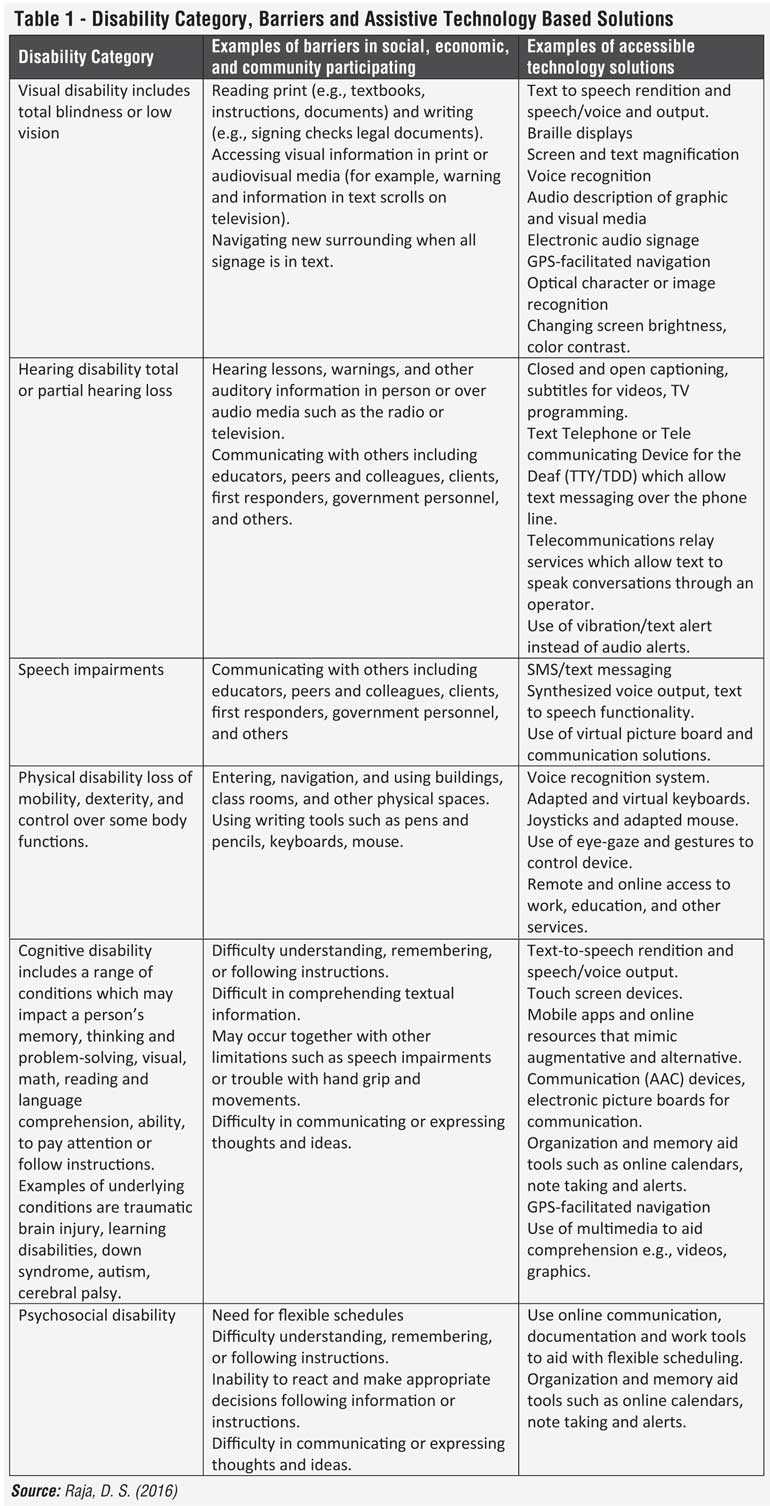Sunday Dec 28, 2025
Sunday Dec 28, 2025
Saturday, 24 August 2019 00:10 - - {{hitsCtrl.values.hits}}

Developing a comprehensive strategy to include disabled persons in the mainstream labour force would help not only to minimise State welfare expenditure but also increase labour force participation. From the labour market perspective, access to workplace and access to public transport are the major barriers faced by disabled persons. For instance, it is hard to provide wheelchair access to workplaces due to steps and other physical barriers. At the same time, differently abled people are unable to use public transport services because of limited alternative boarding facilities – Pic by Shehan Gunasekara
By W.D.U.S.K. Weerasingha
Inclusive growth has become a prominent topic in emerging global development agenda. It attempts to include people who are excluded such as aged population, economically inactive females, differently abled persons and so on, into the mainstream labour force (Udaya Kantha K. K. S. and Perera K. E. D., 2013).
According to the Census of Population and Housing of Sri Lanka conducted by the Department of Census and Statistics in 2012, 8.7% of the total Sri Lankan population (five years and above) are differently abled persons (Approximately 1.6 m persons). Sri Lanka labour force has lost its full capacity due to two youth insurrections, 2004 Tsunami situation and thirty years long civil war in addition born with, disabilities population (Coomaraswamy I, 2017 and Department of Census and Statistics, 2012).
Further, the ageing population phenomenon and increasing accidents have also led to an increase in the number of disabled persons in the country. In line with these developments government health and welfare expenditure increased and labour force started to shrink. Hence, developing a comprehensive strategy to include disabled persons into mainstream labour force would help not only to minimise government welfare expenditure but also to increase labour force participation.
What is disability?
The term ‘disability’ has been defined in various ways by different organizations. For the World Health Organization “Disabilities is an umbrella term, which covers impairments, activity limitations, and participation restrictions. An impairment is a problem in body function or structure; an activity limitation is a difficulty encountered by an individual in executing a task or action; while a participation restriction is a problem experienced by an individual in involvement in life situations” (http://www.who.int/topics/disabilities/en/). This definition is based on health perspective and disabilities and impairment are identified as too close conditions.
In Sri Lanka, Protection of The Rights of Persons with Disabilities Act (No. 28 of 1996) as amended by Act No. 33 of 2003 has defined disability as “a person who, as a result of any deficiency in his physical or mental capabilities, whether congenital or not, is unable by himself to ensure for himself, wholly or partly, the necessities of life”. Although there are some deficiencies with disabled persons, they also have some capabilities which can be used to include them into labour force. However, today many disabled persons fall in to the economically inactive category which amounts to
1.1 million out of around
1.6 million total disabled population (Source: Census of Population and Housing of Sri Lanka, 2012, Department of Census and statistics).
Barriers to enter the labour force
There are a number of barriers that prevent differently abled persons from entering the labour force. Some barriers depend on their disability, and some are common for all differently abled persons.
Lack of proper education is the main reason for unemployment among differently abled persons. This has been caused by barriers faced by disabled persons within existing socio-economic context. Further, as is identified in national policy on disability 2003, environmental and transport accessibility, communication, cultural, lack of assistive devices and societal and family expectations are the other barriers faced by disabled persons in engaging with mainstream society.
From the labour market perspective, access to workplace and access to public transport are the major barriers faced by disabled persons. For instance, it is hard to provide wheelchair access to workplaces due to steps and other physical barriers. At the same time, differently abled people are unable to use public transport services (eg: Buses, Trains) because of limited alternative boarding facilities.
Further, documents in many work places are not accessible for visually impaired people. Therefore, the differently abled, especially the visually impaired people, have to face a lot of information and communication barriers within workplaces. Moreover, it is difficult to address this issue due to lack of affordable assistive devices in the local market.
Furthermore, over or lower protection within families for disabled children prevent socialization of such children. Negative attitudes and stigmatization towards differently abled persons within work places also discourage their labour force participation. From employers’ perspective, they assume that additional costs have to be incurred to employ disabled persons into their firms. For example, necessary workplace arrangements have to be made before enrolling wheelchair users. On the other hand, prejudices on efficiency could also result in excluding disabled persons from the labour market.
Transforming persons from disability to ability: International experiences to national development
With a view to addressing the challenges faced by differently abled persons, various countries have introduced various policies. These policies can be divided into two major categories such as passive measures and active measures (Shima. I et al, 2008).
Passive measures include welfare schemes and other charitable activities. These kinds of policies lead to increase dependency of disabled persons than independency. Hence, many countries have taken actions to transform their policies from passive to active. The key objective of active policies is to empower disabled persons to be independent persons. In other words, these kinds of policies attempt to convert disabled persons from welfare recipients to tax payers.
Disability is caused by one or more impairments. Today assistive technology plays a pivotal role in replacing functions of impaired body parts. Table 1 provides a detailed description of the developments occurred in this field.
As illustrated in Table 1, there are specific assistive technological solutions for respective disabilities to overcome functional limitations. For instance, visually impaired persons can use screen reading software to perform reading and writing activities, leading to an increase in the individual capacity of the differently abled persons, which would in turn increase employment prospects for differently abled persons. Further, some developed countries have introduced number of active policy measures to encourage labour force participation of disabled persons such as Quota system, anti-discrimination law, job protection rights and targeted active labour market policies.
Sri Lanka can also implement new programmes to include disabled persons into national labour force by learning lessons from international developments. As a first step, the Government could provide tax concessions to import assistive devices and respective technological equipment.
Furthermore, research and development should be improved to produce compatible assistive devices to suit requirements of local labour market and disabled persons. Digital infrastructure needs to be developed to promote digital labour supply and it would help to provide online working facility for persons with mobility issues.
In addition to that, the existing national policy on disability should be focused on enhancing accessibility for education, public transport, etc. Using tactile walking surface indicators for roads constructions is a better option to improve accessibility of physical structure for visually impaired persons. Information accessibility could be improved by converting all public documents into an accessible format such as electronic and audio. A central mechanism should be established to improve connectivity between employers and disabled persons. Financial assistance could be provided to employers to make work place adjustments for differently abled employees.
Public Administration Circular No.27/1988 provides for an allocation of 3 per cent job opportunities for disabled persons with requisite qualifications when the vacancies in the public or corporation sector is being filled. This existing quota for public sector employment could be rationalized and expanded into private sector. For instance, national level surveys should be conducted to seek suitable employment prospects for disabled persons in terms of their disabilities and capabilities. An appropriate quota system could then be introduced into private sector.
Japan has introduced disabled employment quota system for both public and private sectors. Accordingly, employers who do not comply with that system are levied to promote disabled employment (Furukoa et al, 2011). Sri Lanka could also consider the possibility of implementing such a system and thus collected tax income can be utilized to rehabilitate differently abled persons.
A new employment center for disabled people could also be established under public private partnership. Similar system, which provides employment opportunities for disabled persons, is at work in Malaysia. The Centre is named “stepping stone”, and comes under Asia Community Service, a nongovernment organization in Malaysia. The center consists of several sections such as baking, hand weaving and yarn dyeing, creative craft, batik printing and pottery. Initially, differently abled persons are given on-the-job training and then, they are encouraged to select one section to match with their potential and preference (Furukoaet al, 2011). Sri Lanka also could adopt such a model under the public private partnership to establish a working center to increase employment opportunities for disabled persons.
Awareness among disabled persons on availability of assistive technologies and availability of employment prospects should be improved. In contrast, awareness among non-disabled persons should be improved on abilities of disabled persons which can be used for value creation in the economy. These two-way awareness process can be used to avoid discriminations and stigmatization towards disabled persons and to empower them. Conducting national level campaigns and introducing disability studies into education curriculum is one way to improve such awareness in the society.
Presently, there are few vocational training centers for disabled persons in Sri Lanka. Service of those centers should be expanded into rural areas and sociologists and psychologists could be employed to enhance the quality of the service.
In conclusion, all above strategies can be proposed to improve labour force participation of differently abled persons and it will ultimately lead to a transformation of differently abled persons from welfare recipients to tax payers. This would also improve the chances of social inclusion of differently abled persons enabling them to contribute effectively to the economic growth in the country.
(The writer is the Senior Assistant Director, Central Bank of Sri Lanka. The views and opinions expressed in this article are those of the writer and do not necessarily reflect the official policy or position of any institution. The author can be reached by via [email protected].)
References
